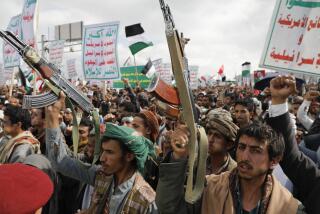Study Cites High Costs of Airliner Antimissile Systems
- Share via
Although airlines face a clear threat from terrorists using shoulder-fired missiles, a new study by Rand Corp. concludes that combating the proliferation of such weapons holds more immediate promise than equipping jetliners with costly and unproven antimissile systems.
The study, released Tuesday, said that using laser technology to detect and destroy approaching missiles would cost billions of dollars to install on 6,800 commercial jetliners and consume too great a share of the nation’s spending on airline safety.
Instead, the study found that the nation’s airports and travelers would be better served by a combination of other security measures that would reduce the possibility of extremists acquiring deadly heat-seeking missiles.
Those measures include buyback programs, such as a CIA initiative that purchased U.S.-made Stinger missiles from militant groups, and new interdiction efforts at borders and transportation hubs, which aim to reduce the chances that shoulder-launched missiles are smuggled into the country.
“The whole question is this: Should we spend sums of money to install countermeasures aboard our airliners right now?” said Rand engineer Jim Chow, the study’s principal author. “And our conclusion is that it wouldn’t be prudent to do that, unless we make them more affordable or, as a nation, decide to significantly increase spending on homeland security.”
The missiles, known as man-portable air defense systems, or Manpads, have been in use throughout the world for more than 30 years. Although most of the 700,000 produced since the 1970s have been manufactured for military purposes, thousands have made their way into the hands of extremists and thousands more remain unaccounted for, many for sale on the black market.
Light, portable and affordable, the shoulder-launched missiles, manufactured by the United States, Russia, Britain and other countries, have been seen as a growing threat to commercial aviation in recent years because they can be fired at aircraft flying as high as 18,000 feet.
Al Qaeda’s leaders, the report says, would “relish” the opportunity to bring down a U.S. jetliner. The terrorist organization has already made it clear -- in a November 2002 attack in Kenya -- that it will use these missiles to strike commercial jetliners, the report adds.
“The fact that no known attempts have yet been made against U.S. civil carriers suggests that either the required assets are not in place or that Al Qaeda’s leaders are waiting for what they regard as a more propitious time to undertake such attacks,” the report says.
But as more security measures have been put in place at airports since the Sept. 11 attacks to make hijacking aircraft more difficult, the report says, “attacking aircraft with Manpads will unavoidably become more attractive to terrorists.”
Using Los Angeles International Airport to illustrate the difficulty of protecting airports in dense urban settings against shoulder-fired missiles, Rand researchers found that terrorists using the latest missile designs could strike an ascending or descending aircraft at LAX anywhere within a 4,600-square-mile region -- an area larger than the entire county of Los Angeles.
Officials at LAX said there had been no credible threats against the airport but they were “very concerned” and were actively working to address it on several fronts.
Shortly after the Sept. 11 attacks, the city and the federal government worked with the Coast Guard to launch a program looking for suspicious activity in the waters off LAX and visited law enforcement agencies in communities within a 20-mile radius of the airport.
Beyond the loss of life, the Rand report says that the potential financial consequences of a downed jetliner could be staggering. The loss of a single airliner could cost $1 billion in aircraft replacement costs and death benefits. The ultimate effect on the economy, from temporarily shutting down airports to fewer people flying, could total $15 billion, Rand said.
But installing antimissile systems on every U.S. jetliner would cost $11 billion and require an additional $2.1 billion in annual operating costs, according to the report.
Given the expense of retrofitting jetliners with sophisticated antimissile lasers, researchers recommended that federal authorities should immediately examine cheaper options, including flares that could be deployed by jetliners to distract the heat-seeking homing device on older versions of shoulder-fired missiles.
The nation’s cash-strapped airline industry applauded the study’s findings.
“The Rand report underscores our belief that missile defense systems being proposed today for commercial aviation consist of unproven technologies that not only would cost tens of billions of dollars to deploy, but could expose the airline industry to other serious threats” by siphoning money away from other security programs, the Air Transport Assn., a trade group representing the nation’s major airlines, said in a statement.
Nevertheless, defense contractor Northrop Grumman Corp. said Tuesday that it would install and test its Guardian antimissile aircraft protection system on two airplanes this year, Bloomberg News reported.
Sen. Barbara Boxer (D-Calif.), who has aggressively pushed for more aircraft safeguards against shoulder-fired missiles, dismissed the notion that onboard defense systems were too expensive to pursue.
“The cost of installing and operating countermeasures on commercial aircraft is a fraction of what we spend on a ballistic missile defense system that has not been proven to work,” Boxer said in a statement.
More to Read
Sign up for Essential California
The most important California stories and recommendations in your inbox every morning.
You may occasionally receive promotional content from the Los Angeles Times.










